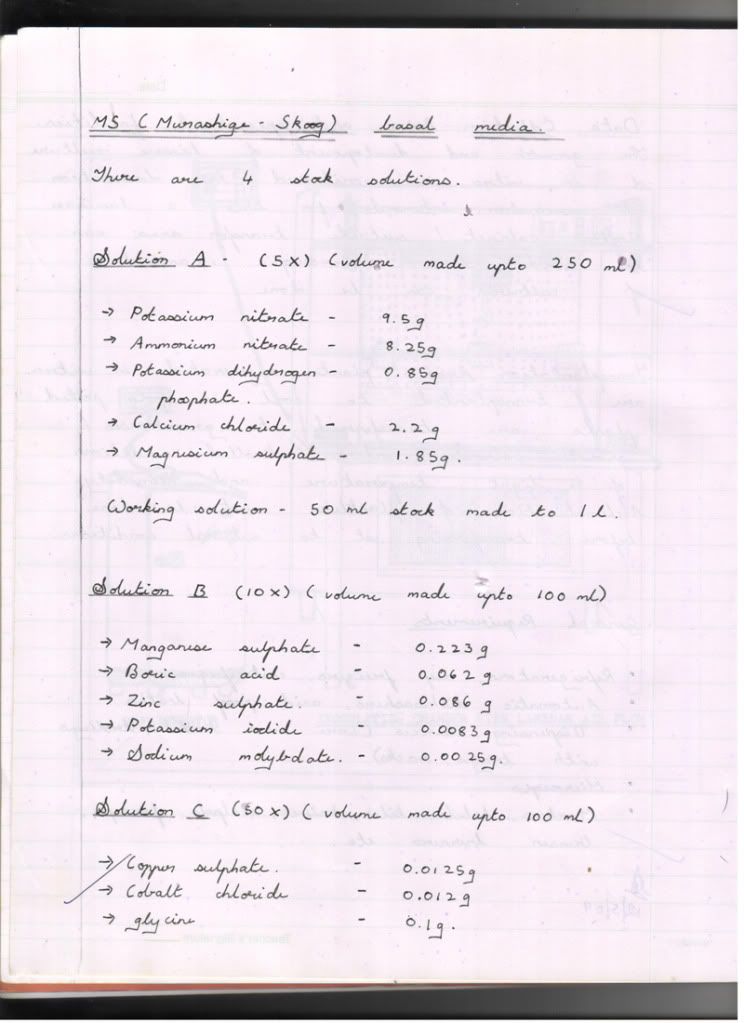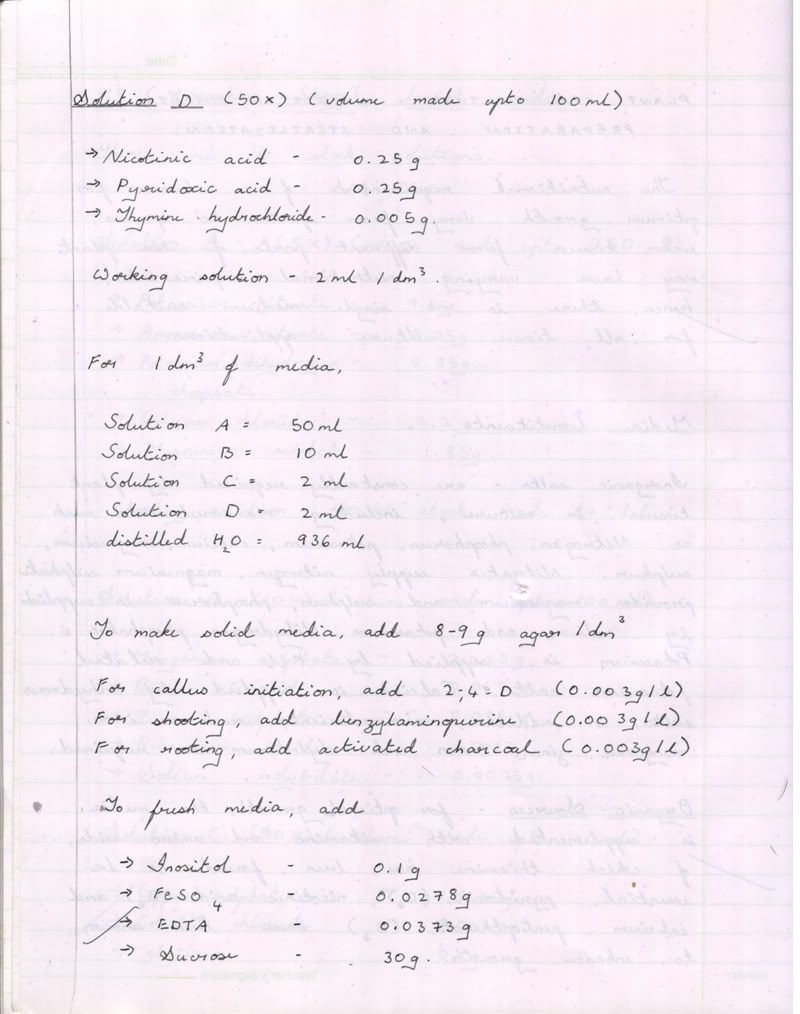Wait a second, but if you're using an egg cell the animal still inherits the random alleles (as per Mendel's Segregation Law) from mommy's egg cell! So, how is it a clone?GenesForLife wrote:When cloning animals, we take an egg cell, and replace the nucleus with one taken from the somatic cells of the animal that is being cloned, the egg cell , upon implantation, develops into an embryo and then onto the cloned animal, embryos at the blastocyst stage have totipotent cells.mistermack wrote:That's interesting. They must have some way around it in the lab though, as they're managing to clone higher mammals now.GenesForLife wrote:Because of totipotent meristematic tissue, Dory, which can produce all the tissues that constitute a plant, in animals like us, however, totipotency is often lost after the cells during embryo development commit themselves to differentiation, after which they're just pluripotent, I actually did that in the plant tissue culture lab at college, DoryDory wrote:Another Question
I don't understand how vegetative growth is possible. How could possibly new plant "individuals" arise or be obtained without production of seeds or spores? It just doesn't make sense to me!
We must be fooling the pluripotent cell into acting totipotently. ( is that a word? ).
.
Dory's Biology Questions Thread
Re: Dory's Biology Questions Thread
- GenesForLife
- Bertie Wooster
- Posts: 1392
- Joined: Sat Aug 08, 2009 6:44 pm
- Contact:
Re: Dory's Biology Questions Thread
We're taking the nucleus of the egg cell out and replacing it with a somatic cell's nucleus , Dory 

I'll try finding a protocol for meristem culture later.

I'll try finding a protocol for meristem culture later.
- GenesForLife
- Bertie Wooster
- Posts: 1392
- Joined: Sat Aug 08, 2009 6:44 pm
- Contact:
Re: Dory's Biology Questions Thread
Found it in my old practical records.
This is the protocol

Medium composition, part 1.

Part 2

This is the protocol

Medium composition, part 1.

Part 2

Re: Dory's Biology Questions Thread
Ah, replace the nucleus! How ingenious.GenesForLife wrote:We're taking the nucleus of the egg cell out and replacing it with a somatic cell's nucleus , Dory
I'll try finding a protocol for meristem culture later.
Too bad I can't read cursive
Re: Dory's Biology Questions Thread
why would the egg cell of a women in her 40's have higher risk of producing a baby that has birth defects than the egg cell of woman in her 20's?
- GenesForLife
- Bertie Wooster
- Posts: 1392
- Joined: Sat Aug 08, 2009 6:44 pm
- Contact:
Re: Dory's Biology Questions Thread
The longer it is in the body, the longer it may be subjected to mutagens et cetera, and therefore more likely to have a damaged genome, with damaged genes, leading to...Dory wrote:why would the egg cell of a women in her 40's have higher risk of producing a baby that has birth defects than the egg cell of woman in her 20's?
you get the point, ey?
This (accumulation of mutations) is one basic reason cancer can often be associated with aging, I have a lecture by Liz Blackburn (she's the one who discovered telomerase) wherein she makes the point that if everyone lived long enough, cancer would be a certainty.
Re: Dory's Biology Questions Thread
So older women keep the fetus more in their uterus than younger women? If so, why is it?GenesForLife wrote:The longer it is in the body, the longer it may be subjected to mutagens et cetera, and therefore more likely to have a damaged genome, with damaged genes, leading to...Dory wrote:why would the egg cell of a women in her 40's have higher risk of producing a baby that has birth defects than the egg cell of woman in her 20's?
you get the point, ey?
This (accumulation of mutations) is one basic reason cancer can often be associated with aging, I have a lecture by Liz Blackburn (she's the one who discovered telomerase) wherein she makes the point that if everyone lived long enough, cancer would be a certainty.
- GenesForLife
- Bertie Wooster
- Posts: 1392
- Joined: Sat Aug 08, 2009 6:44 pm
- Contact:
Re: Dory's Biology Questions Thread
No! Their egg cells will have been in the body for a longer time, that is all.Dory wrote:So older women keep the fetus more in their uterus than younger women? If so, why is it?GenesForLife wrote:The longer it is in the body, the longer it may be subjected to mutagens et cetera, and therefore more likely to have a damaged genome, with damaged genes, leading to...Dory wrote:why would the egg cell of a women in her 40's have higher risk of producing a baby that has birth defects than the egg cell of woman in her 20's?
you get the point, ey?
This (accumulation of mutations) is one basic reason cancer can often be associated with aging, I have a lecture by Liz Blackburn (she's the one who discovered telomerase) wherein she makes the point that if everyone lived long enough, cancer would be a certainty.

The number of egg cells is finite and arises from the germ line (one of the two cell lineages established early in life) , every month one egg undergoes maturation, the others stay in the ovary at the same time in their immature forms. Therefore, those that go first (earlier in life) through menstruation/pregnancy will have stayed in the body for a shorter time than those which go later, and therefore will be exposed to more mutagens et cetera, the precursors that give rise to mature eggs, having stayed longer in the body, and therefore subject to more mutagenesis, can manifest in an increased risk of genome damage and as a consequence, developmental defects.
Re: Dory's Biology Questions Thread
Interesting! I didn't know that fact about egg cells. I wonder if women can take some sort of drug or via stem cell can produce more eggs to increase their finite number...
- GenesForLife
- Bertie Wooster
- Posts: 1392
- Joined: Sat Aug 08, 2009 6:44 pm
- Contact:
Re: Dory's Biology Questions Thread
Well, they have managed to derive gamete cells by inducing differentiation in pluripotent stem cells, a relevant review paper follows...
http://www.biolreprod.org/content/76/4/546.full
http://www.sciencemag.org/cgi/content/a ... eytype=ref
But yes, I did find this
http://www.wired.com/wiredscience/2009/07/humanegg/
http://www.biolreprod.org/content/76/4/546.full
I unfortunately don't have access to Science, or this would've been a great read...Abstract.
Germ cells constitute a highly specialized cell population that is indispensable for the continuation and evolution of the species. Recently, several research groups have shown that these unique cells can be produced in vitro from pluripotent stem cells. Furthermore, live births of offspring using induced germ cells have been reported in one study. These results suggest that it may be possible to investigate germ cell development ex vivo and to establish novel reproductive technologies. To this end, it is critical to assess if gamete induction processes in vitro faithfully recapitulate normal germ cell development in vivo. Here, this issue is discussed with a focus on the germ line specification and the sex-specific development of pre- and postnatal germ cells. The aim of this paper is to concisely summarize the past progress and to present some future issues for the investigation into in vitro gamete production from pluripotent stem cells.
http://www.sciencemag.org/cgi/content/a ... eytype=ref
But yes, I did find this
http://www.wired.com/wiredscience/2009/07/humanegg/
For the first time, scientists have managed to grow mature human eggs from immature cells in the lab, a technique that may eventually help save the fertility of female cancer patients who aren’t eligible for traditional egg harvest.
Researchers from Northwestern University took immature egg cells, encased in a protective sac called a follicle, from 14 women who wanted to preserve their fertility before undergoing chemotherapy. By placing the cells in a unique three-dimensional growing environment for 30 days, the scientists coaxed the cells into becoming what appear to be healthy, functional human eggs.
“It is a major first,” said infertility expert Sherman Silber of St. Luke’s Hospital in St. Louis, who was not involved in the research. “No one has yet tested the eggs by in-vitro fertilization and pregnancy, but they look quite normal and we are all excited about it.”
The traditional way to preserve a female cancer patient’s fertility is to surgically remove fully mature eggs from her ovary, fertilize the eggs immediately in the lab, and freeze the resulting embryos. But since only one follicle matures each month for ovulation, that method requires two to six weeks of hormone therapy to generate enough mature eggs for harvest.
“The cancer patient usually does not have this much time to waste,” Silber said. “And to give her any kind of assurance, you would have to put her through three to six or more such cycles to get enough eggs to be comfortable. With ovary tissue freezing, we will get hundreds of thousands of eggs, and the patient can get a much greater measure of security for her future fertility.”
In addition, giving high doses of hormones is dangerous for patients with certain types of cancer, such as breast or ovarian tumors, and the traditional method won’t work for girls who haven’t gone through puberty. If physicians could take immature ovarian follicles and grow them into eggs outside the body, they could skip the hormone step altogether.
Until now, however, no one has been able to grow human ovarian follicles in the lab. Most previous attempts had involved trying to culture the cells in a two-dimensional environment, but it turns out that any kind of pressure on the egg cells inhibits their growth.
“Scientists had been putting them on a flat piece of plastic for years,” said fertility researcher Teresa Woodruff of Northwestern University, a co-author on the paper published Monday in Human Reproduction. “When you do that, the cells around the egg begin to move away, and the connection between the egg and its supporting cells is lost.”
The supporting cells are critical, Woodruff said, because they provide the hormones and nutrients that the egg needs to grow. To create the ideal growing environment for a follicle, the researchers collaborated with biomedical engineers who specialize in biomaterials.
“Our breakthrough was to use a hydrogel called alginate, which doesn’t touch or contact the follicle cells, but just supports them,” Woodruff said. It turns out that the rigidity of the gel is crucial to follicle function: If the gel is too stiff, the follicles start looking sick and making the wrong kind of hormones. “We kind of lucked out in the very beginning in that we used a very soft gel,” she said.
After incubating the follicles for 30 days in the three-dimensional matrix, the researchers discovered that they had grown to the size of mature eggs and were producing all the right hormones, such as estrogen and progesterone, in the right quantities.
The true test of the lab-grown eggs will be to see if they can undergo a final stage of cell division to be ready for fertilization.
“We did it in a mouse and got it all the way to fertilization and live birth,” Woodruff said. But regulations from the National Institutes of Health won’t let scientists fertilize human eggs for research — the final step of the process must be done by physicians in an infertility clinic for a patient who’s ready to have a baby.
“The proof would be if they could fertilize the eggs in vitro and get babies out of it,” Silber said. “But that’s an extra stage, and it’s amazing they’ve got this far.”
“Ten years ago it was considered such an impossible task that we didn’t think it would happen for another 50 years,” he said. “The amazing thing is that it turned out to be much simpler than we ever dreamed.”
- mistermack
- Posts: 15093
- Joined: Sat Apr 10, 2010 10:57 am
- About me: Never rong.
- Contact:
Re: Dory's Biology Questions Thread
I imagine in years to come girls will routinely have a lot of eggs frozen when they are young, so that they can use them later in life without the risk of degraded dna.
( That is if freezing doesn't do an equivalent amount of damage ).
I actually think that in the next thousand years, they will be able to grow a womb from the woman's stem cells, and carry the fetus to full term in that, so you don't have to be pregnant at all.
.
( That is if freezing doesn't do an equivalent amount of damage ).
I actually think that in the next thousand years, they will be able to grow a womb from the woman's stem cells, and carry the fetus to full term in that, so you don't have to be pregnant at all.
.
While there is a market for shit, there will be assholes to supply it.
Re: Dory's Biology Questions Thread
How cushy!mistermack wrote:I imagine in years to come girls will routinely have a lot of eggs frozen when they are young, so that they can use them later in life without the risk of degraded dna.
( That is if freezing doesn't do an equivalent amount of damage ).
I actually think that in the next thousand years, they will be able to grow a womb from the woman's stem cells, and carry the fetus to full term in that, so you don't have to be pregnant at all.
.
- GenesForLife
- Bertie Wooster
- Posts: 1392
- Joined: Sat Aug 08, 2009 6:44 pm
- Contact:
Re: Dory's Biology Questions Thread
Bokanowskification or something from Brave New World?mistermack wrote:I imagine in years to come girls will routinely have a lot of eggs frozen when they are young, so that they can use them later in life without the risk of degraded dna.
( That is if freezing doesn't do an equivalent amount of damage ).
I actually think that in the next thousand years, they will be able to grow a womb from the woman's stem cells, and carry the fetus to full term in that, so you don't have to be pregnant at all.
.
- mistermack
- Posts: 15093
- Joined: Sat Apr 10, 2010 10:57 am
- About me: Never rong.
- Contact:
Re: Dory's Biology Questions Thread
Maybe, but maybe they would do it so they could stay at work and not lose months of salary.Dory wrote:How cushy!mistermack wrote:I imagine in years to come girls will routinely have a lot of eggs frozen when they are young, so that they can use them later in life without the risk of degraded dna.
( That is if freezing doesn't do an equivalent amount of damage ).
I actually think that in the next thousand years, they will be able to grow a womb from the woman's stem cells, and carry the fetus to full term in that, so you don't have to be pregnant at all.
.
I think they will just meet someone they like, phone the lab that has their samples stored, and then just wait nine months and have the baby delivered to the door.
( If they are busy high flyers ).
I don't think it's in the least fanciful. Two or three hundred years would be plenty of time for medical technology to get that far.
I can just imagine telling the kid the facts of life:
"Where do children come from daddy?" "Well dear, when a man and a woman are very much in love, they both send an email to the gamete storage and reproduction facility...." .
It does't have the same ring to it.
.
While there is a market for shit, there will be assholes to supply it.
Who is online
Users browsing this forum: No registered users and 13 guests